Your ecommerce product catalogue serves as a digital storefront where you can present your products for customers to peruse and (hopefully) purchase. This makes it one of the most crucial aspects of running a successful ecommerce business.
A product catalogue that contains all the necessary information about your products benefits both you and your customers. While a well-organised product catalogue can help your brand drive sales, it can also be a valuable back-office tool for merchants as they manage their inventory.
In this post, we’ll cover some examples of great product catalogues and share some tips for optimising your own.
What is a product catalogue ?
A product catalogue is a means of communicating product information to guide buyers in their purchasing decisions. It includes important product details, such as its features, price, colour, description, dimensions, weight, availability, ingredients, and customer reviews.
Traditionally, product catalogues (also called product brochures) were a type of printed marketing collateral shared with potential buyers. Today, product catalogues are digitalized so that ecommerce businesses can easily share their product information with shoppers through their websites.
Online product catalogues also make it easy for brands to export information about their entire product range and manage inventory levels and details across different sales channels.
What are product catalogues used for?
Externally, ecommerce brands use product catalogues to display their products to customers visiting their website. This kind of catalogue page allows shoppers to view all a brand’s products in one convenient place, without having to visit an in-person retail location. Customers may also be able to apply certain filters (such as item type, price, colour, etc.) to narrow their search, and help them find the products they’re interested in more quickly.
Internally, ecommerce brands use product catalogues to help them manage their inventory strategy – especially across different sales channels and platforms.
For example, using a product catalogue page that’s built into an inventory management system, a brand can see key information about each SKU (such as SKU number or product code, price, item description, and related product variants) at a glance.
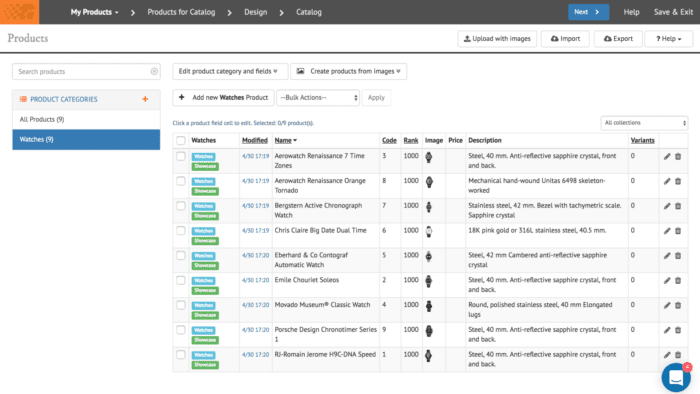
Product catalogues also make it easy for ecommerce stores to create separate groups of products and publish them for certain customers based on specific conditions. For example, you could have a catalogue to publish products available for North American customers with USD pricing and a separate catalogue with EUR pricing for European customers.
This is especially useful when presenting the same products across multiple sales channels. For instance, on ecommerce platforms like Shopify, you can create catalogues tailored to your B2B customers which display wholesale pricing, rather than your DTC pricing. The platform even lets you customise your catalogue so that volume pricing is applied only to specific products, while you have fixed prices for other products. For example, you can set it so that the 20% wholesale discount applies to all your products except for two items that must be sold at a fixed price because they cost more to produce.
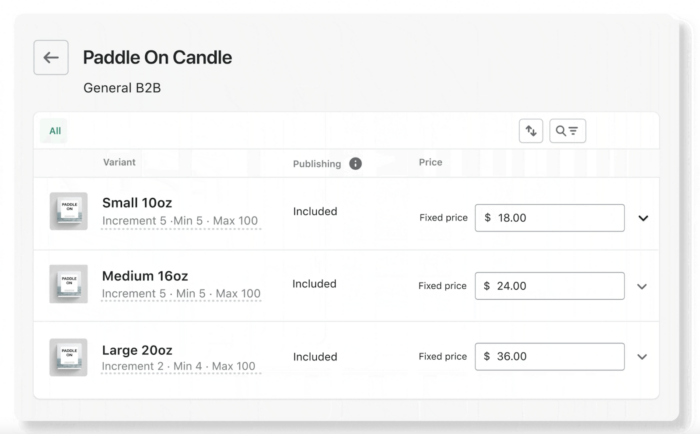
Product catalogue examples to be inspired by
To better understand how product catalogues work, let’s take a look at a few well-crafted product catalogue examples.
ShipBob
ShipBob’s Product Catalogue is a tool that brands can leverage internally to organise their inventory and track SKU movement throughout the entire fulfilment process.
The page is neatly organised, with tabs to navigate between active, inactive, digital, and bundle products. Besides product names and SKUs, merchants can easily view other essential information, such as product categories and sales channels. The page also allows a merchant to add variants, merge them, move them under a different product, and many other actions that may be necessary for effective catalogue management.
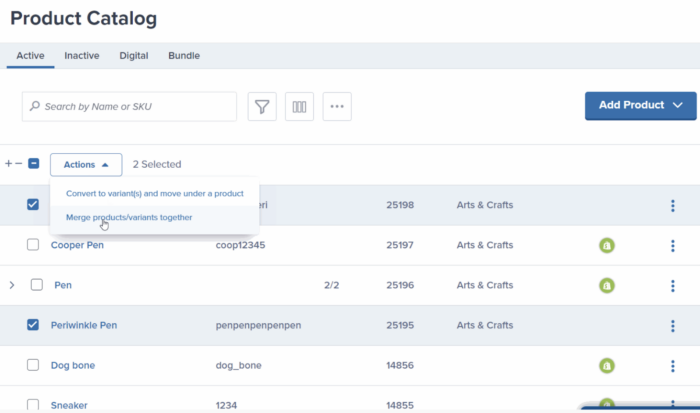
Fabletics
Fabletics uses their external-facing product catalogues to create highly personalised shopping experiences for potential customers. The brand asks you a series of questions related to the products you’re looking for, the colours and patterns you like, and the size you need. The website then displays a product catalogue that’s uniquely tailored to the needs and preferences of each customer. For example, if you specify that you’re looking for “bottoms” in the questionnaire, you’ll get a personalised selection of leggings and pants that match your preferences.
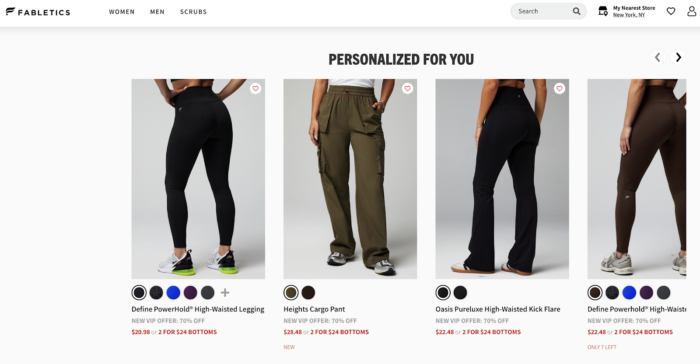
Nordstrom
Similarly, Nordstrom tailors the product catalogue displayed to a customer based on where they’re located. The website displays product prices in the respective currencies of each shopper’s country, and also has a “Trending Near You” section where it showcases the most-viewed items by shoppers in the respective areas.
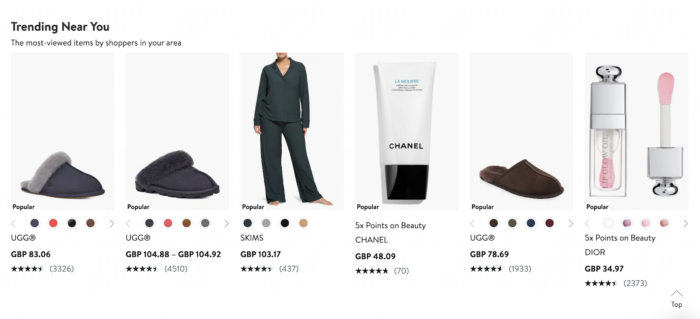
4 benefits of a well-optimised product catalogue
Having an optimised product catalogue is essential for ecommerce success. Here are some key benefits of having a well-crafted product catalogue .
Enhancing the user experience
When your product catalogue is optimised, products are displayed with the most updated and accurate information. Shoppers can easily access this information in one page or in just a few clicks, meaning they don’t have to dig too deep or navigate too far to find the information they need. This makes it much easier for customers to find what they’re looking for, which increases the likelihood that they will convert.
Organising product information
A well-constructed product catalogue lists all the necessary product information – including features, prices, reviews, images, and more – and organises it in an easily-digestible format. This means that both shoppers and merchants can find the data they need quickly.
Guiding purchase decisions
With access to crucial product information, customers have the data they need to confidently decide whether to buy a product. On the backend, merchants can use their existing product catalogue to hone their product assortment, and make better decisions about what inventory to invest in.
Managing product variants
Well-optimised product catalogues make it easy for merchants to manage all their product variants, which is particularly important for brands that have hundreds of SKU variations.
You can use a product catalogue dashboard to add or remove product variants as needed, with many platforms giving you the option to bulk import your SKU variants in one go. You won’t have to create a separate webpage for each variation, as all the variants will be housed under the parent product page.
On the front end, different variations of each product will be displayed on a single page and shoppers will simply have to click on the variation they want to view instead of having to search for it separately. For example, they’ll be able to click on the yellow colour icon on the same product page, without having to navigate to a separate one.
How to optimise your product catalogue
With so much riding on it, deciding how to organise and display your product catalogue can feel a little overwhelming. Here are some steps to help you optimise your external-facing product catalogue efficiently and effectively.
Product selection
Start by carefully selecting the products to include in your catalogue . To select the best product assortment for a catalogue , ask yourself a few questions:
- What is the audience for this particular product catalogue ?
- Do you need a catalogue for this audience?
- Which product categories should be included in the catalogue ?
Your answers to these questions will help you determine which products make sense to include in each catalogue . For example, if you’re selling a certain collection of products only in the United States, you’ll want to create a special US catalogue to make sure the products from this collection aren’t displayed to shoppers in Europe.
Product catalogue design
A crucial aspect of product catalogue optimisation is choosing a design that’s cohesive and consistent with your branding. Make sure to use colours, fonts, product images, and other design elements that align with your brand’s style guide. This helps to ensure that people can connect your product catalogue to your brand.
It’s also important to choose a layout that’s easy for visitors to use and navigate. You’ll want to include visuals and balance them effectively with text to enhance the visual appeal. Leave enough space to ensure that your page is clutter-free, so shoppers don’t feel overwhelmed, and make sure that links load quickly and correctly. You can make use of product catalogue templates to help you with this step.
Product data accuracy
A product catalogue is false or outdated product information is useless at best, and actively detrimental to customer loyalty at worst. If a product’s information is not highly accurate, you risk surprising customers and disrupting their expectations (which is almost never good).
As a result, it’s incredibly important to keep product information up-to-date. Make sure the details you include are complete and uniform for every product in your catalogue . Don’t forget to double-check for small errors such as typos, text errors, and pricing mistakes that could confuse your buyers.
Additionally, it’s vital that the information in your catalogue reflects the latest changes in your product or pricing. For example, discounts should be accurately reflected as soon as they go live. Similarly, feature or ingredient changes should be updated in the product descriptions.
Availability, in particular, should be updated in real-time. You don’t want to have customers purchasing an item that reflects as “available” in your catalogue when you’ve actually run out of stock. It’s important to ensure that your catalogue is directly integrated with your inventory management software so that you can display the most updated information based on your stock availability.
Product data organisation and retrieval
Even if your product data is accurate, it won’t benefit customers unless it is presented logistically and digestibly. A product catalogue should be organised, so that it’s easy for customers to search through your product assortment.
Depending on the size of your product catalogue , this may involve sorting your products into categories, groups, or even subgroups. Parent products will need to be presented differently than their variants to avoid confusion, and any written product information should use headers, subheadings, and bullet points. This makes the information easy to navigate and process, which improves readability and user experience.
Product management just got a makeover: Introducing ShipBob’s Product Catalogue
While it’s important to carefully design your external-facing product catalogue , it’s also important to optimise your internal one.
Since product catalogues are instrumental to an ecommerce brand’s logistics, many inventory management software and fulfilment providers build product catalogue capabilities into their solutions. Ecommerce brands may choose to leverage these features to simplify their tech stack, and achieve a more sophisticated solution than they could create themselves.
As a leading global omnifulfillment platform, ShipBob’s software includes Product Catalogue capabilities. ShipBob’s Product Catalogue features simplify inventory management by letting you manage all your products through a single dashboard, plus so much more.
SKU management
ShipBob’s Product Catalogue assigns a unique SKU identifier for each product to streamline the SKU management process. These SKUs stay consistent across sales channels, which provides your brand with a single source of truth and minimal confusion.
When integrating a new a sales channel – for example, connecting your Shopify or Amazon store – you can sync your new platform’s data with ShipBob. ShipBob’s dashboard will automatically identify matching product information, recognise it as an existing SKU, and register a new sales channel to that SKU (rather than creating a whole new SKU altogether). This helps minimise unnecessary duplicates while also saving you the time of merging SKUs by hand for every sales channel.
If data doesn’t match any existing SKU, our system will automatically identify it as a new product and assign it its very own unique SKU number.
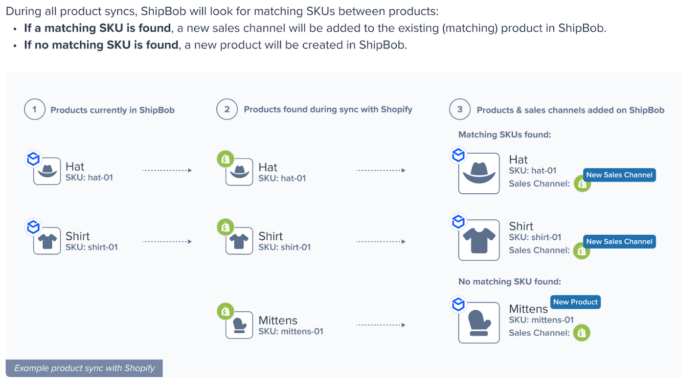
When your SKU information is accurately updated in the system, you can accurately track SKU-specific performance metrics. You’ll be able to see which SKUs are selling well, which ones are slow to sell, which ones are running out, and so on. This information is updated in real-time so you can plan your procurement accordingly – whether it means setting SKU-specific reorder points or removing unpopular SKUs.
Variants and parent/primary products
One of the key features of the ShipBob Product Catalogue is the ability to add variants to products. When variants are properly set up in your catalogue , you can avoid confusion when managing your inventory, and make it easier to introduce and organise new product variants in your assortment.
You can use the Product Catalogue to create new parent/primary products and variants from the “Add Product” drop-down menu. Then select the option “Add Product” to add information about the base product, category, variant name, and variant SKU.
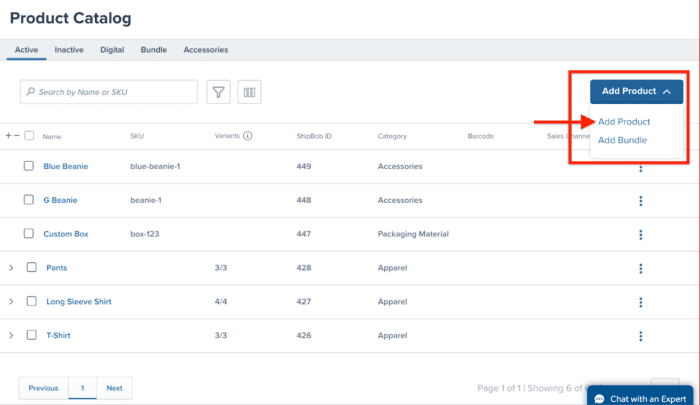
You can switch existing products into variants. Start by using the search bar to locate the product you want to convert into a variant. Clicking on the three vertical dots under the “Action” button will give you the option to convert the existing product into a variant and move it under a parent product.
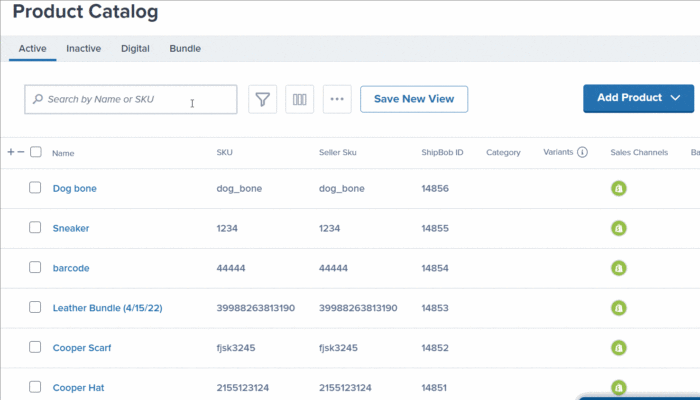
Alternatively, you can also move existing variants to a different parent/primary product. You’ll find the option to do this by selecting the variant you want to move and clicking on the three vertical dots, which will open up the option to “Move to a different product.”
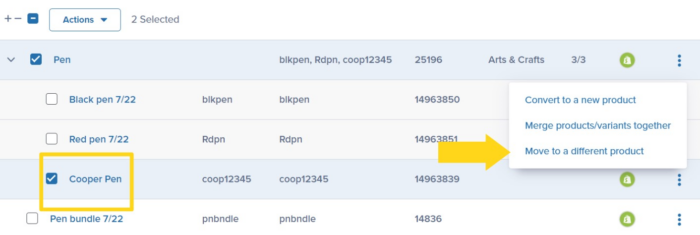
Integration with sales channels
ShipBob integrates with dozens of leading ecommerce platforms and marketplaces, including Shopify, BigCommerce, and NetSuite. Seamless integrations with these sales channels help you streamline your product catalogue management, and ensure that your product information stays updated and accurate across every channel.
ShipBob’s software incorporates real-time inventory tracking at the SKU level, making it easy to display omnichannel stock availability in your product catalogue . You can ensure that every channel is synced to display the most updated inventory data, so an out-of-stock item isn’t accidentally marked as “available” – no matter where you’re selling.
Customisation and filters
The ShipBob Product Catalogue page comes with advanced filters to customise your view to your liking. You can add or remove columns to ensure that you only see what you need, and even rearrange them using the drag-and-drop icon to optimise the view. Additionally, you can add or remove filters and apply advanced filters to streamline your search.
For more information on ShipBob’s Product Catalogue , or on how ShipBob’s fulfilment solutions can help you improve your inventory management, click the button below.
Product catalogue FAQs
Below are answers to common questions about product catalogues.
What is the main purpose of the Product Catalogue in ShipBob?
The main purpose of ShipBob’s Product Catalogue feature is to help merchants easily manage all their products and SKUs in one place. It allows them to view every product they sell across all channels, along with information such as SKU, variants, category, sales channels, barcodes, and ShipBob ID. It also allows them to merge SKUs, create variants, move variants to a different parent product, and more.
How do I integrate my sales channels with ShipBob’s Product Catalogue ?
You can integrate your sales channels with ShipBob’s Product Catalogue by going to the “Sales Channel” tab and clicking on the option to “Add Platform.” This will open a drop-down menu where you can select the sales channel platform you want to add.
Can I customise the view of my Product Catalogue in ShipBob?
Yes, you can customise the view of your Product Catalogue in ShipBob by adding columns you want to view, removing columns you don’t need, and rearranging columns to suit your needs.
I have products with expiration dates. Can I manage them in the Product Catalogue ?
Yes! ShipBob lets you manage products with expiration dates by adding lot products in the Product Catalogue . You can do this by clicking on the “Inventory” tab and going to the “Inventory Details” tile. Then tick the box next to “Is a lot product?” You can then insert a lot number and expiration date.
What if I encounter issues or have more questions about ShipBob’s Product Catalogue ?
If you encounter issues with ShipBob’s Product Catalogue or have more questions about it, get in touch with the ShipBob Merchant Care team for help.



